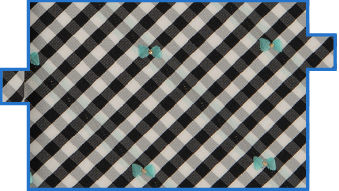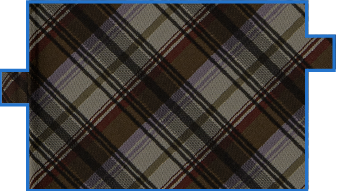Made in Kiryu: Makino Collection Textiles
Makino of Nishide, Inc. shares a variety of amazing Japanese-made textiles with us in the Makino Collection series, which makes a comeback in the Hobonichi Techo 2020 lineup eight years after it last appeared. For this year’s cover, Makino picked out textiles from the fabric maker Mitasho, established in 1932 and located in Kiryu City, Gunma Prefecture. We sat down with Mita, the managing director of Mitasho, and learned more about each textile.
- Thank you for meeting with us today. Could you start out by telling us about the textiles used in the Makino Collection techo covers?
- Mita
- First I’ll explain the weaving process. Depending on differences in the looms, woven fabrics can be made with a Dobby weave or a Jacquard weave. Dobby weaves are made with machines that work similarly to a hand-loom and move all the vertical threads in tandem. This means there are certain limitations to the types of materials that can be woven this way. With a Jacquard loom, every vertical thread can be moved independently, so it can accommodate more complex designs. Kiryu is famous as a Jacquard-weave production town.
- So the textiles used in these covers are a Jacquard weave. It’s amazing to see a woven pattern that’s so complex it looks like a printed design.
- Mita
- Yes. Which isn’t to say that prints don’t have their own appeal. There are no limitations in the colors of a print, and the sizes can be adjusted however you’d like. Jacquard weaves have limits in the size of the pattern, depending on the type of machine and density of the threads, so these patterns are created within those constraints. But the surface of a print could never have this nice, textured feel.

- There’s such a nice texture to the textiles used in the covers. They’re fun to touch.
- Mita
- I’m happy to hear that. We’re so accustomed to it that we have a hard time seeing these things objectively anymore. And we get so caught up in the world of these textiles that we’ve reached a point where we can’t tell if this is even what customers are asking for anymore! (Laughs) But the textiles used in these covers were actually made more than ten years ago.
- About how many types of fabrics do you have at Mitasho?
- Mita
- They don’t all exist anymore, but we’ve made more than ten thousand varieties. Some of our oldest designs were made with threads that have since been retired, or with machines that aren’t around anymore, so even we aren’t able to reproduce them.
- What a shame.
- Mita
- It really is. But we do what we can. We adjust designs like that for production today. Years ago, polyester felt inferior to natural fibers. But there are modern polyester threads called high-count polyester that are made with incredibly thin fibers. Weaving with those threads makes a really nice texture, so it’s commonly used now in the fashion world.
- So it’s not that it’s all disappearing, so much as just evolving in places.
- Mita
- Right. So we’re coming out with new textiles in response to the specific needs of customers by incorporating new materials.

 Desk Garden> Details
Desk Garden> Details
- Mita
- The base textile for this design, the green fabric, is 100% cotton. You see the white spots popping out from it? That’s called Papilio. Papilio has come to be in really high demand for clothing. But weaving the white threads horizontally as-is would make the design flatten out, so we have to pull a few threads from those already woven in random directions into the textile. This allows the Papilio patterns to be dotted around the textile.
- So that’s what creates those complex visuals. How are those Papilio designs woven in?
- Mita
- It starts with a long, white thread that gets woven into the design, and then we cut excess threads off. The light pink flowers and blue triangles in the design are cut from the back.
For example, if we didn’t cut any threads off of the pink flower parts, you’d be able to see a thread connecting all the flowers from behind. That loose thread between flowers would catch on things, so we cut it. This keeps the textile nice and light.
Going through the laborious procedure of snipping threads on both the back and front of this design makes it a really extravagant process. - Is it really that extravagant to cut threads?
- Mita
- It is! We have a specialist who does it for us, and cuts it all by hand.
- By hand?!
- Mita
- They use a tool that’s like a specialized razor to cut all the threads.
- The areas around the flowers have this almost hazy, blurred, dreamlike look to them.
- Mita
- We weave those in a way that makes the threads stick out as much as possible. Cutting the back of the threads surrounding those areas ensures that the threads won’t come undone.
 Lily of the Valley> Details
Lily of the Valley> Details
- Mita
- This textile uses a slightly different methodology than Desk Garden. The base fabric is woven together with a combination of blue and navy threads. For the beige parts in the Lily of the Valley design, the threads are woven together in a way that only the petals show up on the front, and unneeded areas on the back of the fabric are all snipped off. So the parts with the Papilio designs are the same as those in Desk Garden.
- The materials are different too, right?
- Mita
- The horizontal threads in Lily of the Valley are a blend of cotton and linen, and the vertical threads are thin and made with nylon. Those are the blue and navy colors. The navy is only visible through the leaves of the flowers.
- I see there are diagonal lines in the textile, too.
- Mita
- This is a weaving technique called a double weave, where there’s a front and back fabric that are woven together with diagonal lines to make sure they don’t pull apart. You can get a lot more detailed and include zig-zag designs. But it’s not good for the background cloth to be too busy in that case, so I kept it at a level that would help the motif stand out.
- But keeping these lines visible makes it looks sharp.
- Mita
- Yeah, threads are everything when it comes to the quality of a fabric. When you can actually see the threads making up the fabric, that gives it a really warm feel.
 Navy × Brown> Details
Navy × Brown> Details
- Mita
- This one was finished differently than Desk Garden and Lily of the Valley. It’s not carefully flattened out, but instead all the lumps and bumps from the weaving process are left in the textile. In fact, they’re almost emphasized in places.
- So that unevenness is intentional.
- Mita
- This type of woven material allows for the enjoyment of that bumpy texture.
- These thin, sparkling silver threads give it a really nice accent.
- Mita
- These thin threads are incredibly difficult to weave with. They’re actually wrapped with water soluble vinylon yarn when woven into their threads.
- So that goes into weaving each individual silver thread?
- Mita
- The silver thread first comes as something called slit yarn, which is cut from a flat sheet. If you cut it thick enough you can weave with it as-is, but when it gets twisted it looks frayed and is rough and unpleasant to the touch. But by cutting it very finely, the flatness goes away, you can’t see if it’s getting twisted, and it softens into what feels like a normal thread. But at the same time, it’s quite weak in that state, so it stretches and snaps quite easily. That’s why it’s then wrapped with water soluble vinylon yarn to support it and keep it together, and that vinylon yarn is still on the slit yarn when it’s woven into the textile. The textile is then washed to dissolve the vinylon yarn. After that stage, you can really see the difference in the weaving styles. After it’s washed, the fabric is sun-dried, and as you can see in this fabric it’s finished in a way that preserves the bumpy texture.
 Mint Ribbons> Details
Mint Ribbons> Details
- Mita
- The checkered base for this design is a textile called a Dobby weave. When a woven piece has an extremely simple design, even though it technically has a pattern on it, we refer to it as being plain—as in solid-colored. But since this one has ribbons on it, it’s no longer considered plain.
- The ribbons look woven into the fabric.
- Mita
- Yes, the saxe blue threads are woven into the shape of a ribbon. The golden threads woven into the center of these ribbons is actually the same thickness as the silver threads in the Navy x Brown cover. The difference is that these gold threads are held together by nylon yarn, not water-soluble vinylon yarn.
- And that’s to reinforce it?
- Mita
- Yeah. The threads are so thin that you can’t even weave with them if you don’t reinforce them. Since this textile isn’t washed after it’s finished, nylon is used for the reinforcement threads. The fabric turns out really nice as-is after it’s done.
So the method of finishing a fabric depends on how it will be used and how customers view it—we consider the final steps and whether it will be washed or not with the final image of the textile in mind.
 Tartan> Details
Tartan> Details
- I can see how, within this plaid design, a single black line will appear pitch black in some spots, and in others take on a subtle pattern.
- Mita
- Yeah, that’s a characteristic of textiles made on a Jacquard loom. Each thread is moved independently. The black parts are made with a mix of a shiny, firm satin weave and a style of weave more intricate than satin. So even among the same black areas, the appearance of the black color varies, thanks to the complexity of the textile. The Jacquard loom is what allows for that freedom in variations.
We went on a tour of the Mitasho factory.
After our talk, Mita was gracious enough to show us around the factory. We were able to see Jacquard looms in action, as well as actual textiles from the Desk Garden design hanging up to dry.





(The End)